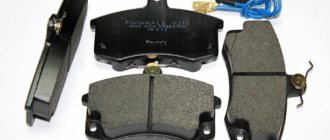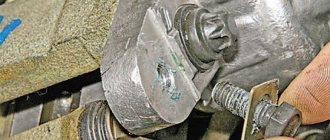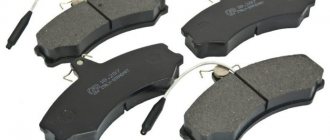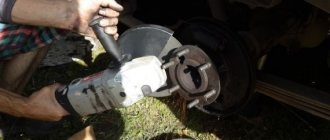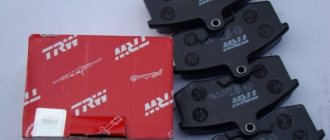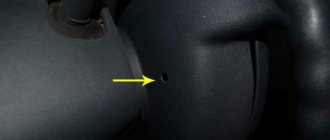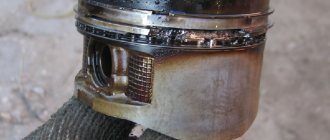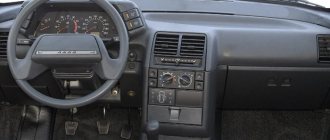Brake pads in a car belong to the category of consumables, the scope of which involves gradual natural wear. This pattern also affects the modern Russian model of the universal class Lada Largus. The service life of the pads is directly influenced by the intensity of use and driving style. On the rear axle, these consumable components are replaced much less frequently than on the front axle, since the operating principle of the entire assembly is based on greater braking force on the front mechanisms.
In order for the replacement of rear brake pads on a Lada Largus car to be successful, you need a clear understanding of the structure of the brake unit, both as a whole and its individual components. Our material is aimed at considering the design features of the brake system parts and the sequence of manipulations that should be resorted to when the need arises to replace the rear pads. We will also provide a number of recommendations to extend the resource intensity of these consumables.
Types of brakes
In the automotive industry there are three main categories of brake mechanisms installed as standard:
- strip structures;
- drum systems;
- disc brakes.
The first “instances” at the dawn of the automobile industry had band brakes. This product covered the entire perimeter of the wheel rim, which allowed the driver to direct the braking force there at a certain moment. He could only pull the tape, which led to the slowdown of the “cart”.
Evolution has done its progressive work, and the outdated “ribbons” were replaced by drums, as in the Lada Largus. The principle of their operation was not intricate, but involved free rotation of the wheel paired with a drum, which, by expanding the pads present in its cavity, received the braking force, causing the car to slow down. This concept worked quite well, but over time some of its shortcomings became apparent. Here the intensity of the drum system has a special influence. The design is closed, and the pads overheat very quickly, which directly affects the deterioration of the braking effect. Along with excessive heating, moisture ingress turned out to be detrimental to the drum mechanism. The presence of water and dirt inside the assembly causes a decrease in performance. It is also not uncommon for a part to break inside a closed drum mechanism. On the one hand, the noise that appears will provide the driver with information about the breakdown that has occurred, and on the other hand, it can provoke damage to the internal working area of the drum itself.
The disc brakes installed in Lada Largus have proven to be the most reliable. In them, all the shortcomings inherent in the previous categories are completely leveled out. The operating principle is as follows. Paired with the wheel, the brake disc itself rotates until it is subjected to the compressive force of the pads. This action is possible by moving the brake rod from the cavity of the hydraulic cylinder present in the caliper. The disc uses a ventilation system that allows you to effectively cool the working area during intensive braking. Note that in the vast majority of cars only the front mechanisms are ventilated. Also, the fact that moisture gets on the disk cannot cause significant damage, since it dries quickly, and the remaining debris is spontaneously removed by centrifugal force. Although there are frequent cases of disc distortion due to frequent alternation of overheating and the passage of water “obstacles” (puddles). The disk mechanism better tolerates loads, so the entire system is as efficient as possible.
Due to the significantly lower cost of drum assemblies compared to disk counterparts, many manufacturers in their budget models resort to a combination of mechanisms, with disks in front and drums in the rear.
About the operating principle
The brakes in the Lada Largus turned out to be quite balanced and effective. This is confirmed by a lot of tests. For this station wagon, the manufacturer has provided the possibility of equipping it with the following mechanisms:
- front axle – disc units, which are equipped with the function of ventilation and holding a floating bracket;
- rear mechanisms - drum.
The stern brake components are traditional closed designs that are equipped with mechanisms that allow the pads to self-center. Due to this action, the gap is adjusted.
The pads are driven by a hydraulic system, the actuators of which at the front and rear are brake cylinders with retractable pistons. The entire system is dual-circuit, where the order of distribution of braking force occurs according to a diagonal pattern. The complex also has a vacuum booster.
Many cars today are equipped with a useful ABS system. This mechanism prevents the wheels from locking when the brakes are activated, which is especially important in extreme braking modes, when there is a high probability of skidding.
The parking brake is activated via a corresponding lever located in the passenger compartment. The force on the pads is transmitted by a cable located under the bottom in a special line.
The forums are full of questions regarding modifications of the pads installed on the LADA Largus configuration, both with eight and 16-valve engines. Note that the manufacturer installs different brake mechanisms for different versions of the model, which have their own geometric parameters of discs and calipers. The brakes installed on modifications with 16-valve units are more effective.
Checking the operation of the hand brake
There are two methods to find out whether the parking brake system on the Lada Granta is in order. They work separately: if at least any type of check shows something wrong, the handbrake needs adjustment. What will you need:
- The car is stopped on an ascent or descent with a slope of about 23-25 degrees, then the handbrake is put in the raised position and turned off; what remains for our client to do is transfer. At the same time, the car should remain in one place and not even roll down. If this happens, the handbrake
is working properly and nothing threatens you. Otherwise, the handbrake on your car needs adjustment. - manual braking accounting programs is checked . If the ratchet mechanism clicks 2-4 times before being completely moved to the parking position, there is no need to worry, the handbrake is working properly.
How to replace rear pads?
Let's move on to consider the sequence of actions when replacing the rear brake pads.
Attention! The pads located on both sides of the car should be replaced. You should also use products from the same manufacturer and identical modification.
- Loosen the tightening torques of the wheel bolts on the rear axle.
- We hang the car (or part of it) using a suitable lifting device.
- The LADA Largus engine, of course, must be turned off and the handbrake deactivated.
- After removing the wheel from one side of the car, we find the brake drum. Let's dismantle it.
- Pads with or without ABS are placed along the edges of the mechanism. The parking brake activation lever directly interacts with one of them. A cylinder is located between the upper edges of the pads. We also observe the presence of springs and a spacer bar, which are necessary to be able to adjust the gap.
- We begin the disassembly steps by dismantling the tension springs, and we remove not only the upper one, but also the lower one. This manipulation can be conveniently performed with pliers. Don't forget about the guide springs.
- We proceed to removing the bar itself along with the mechanism that allows you to “select” the gap.
- It remains to remove the end of the parking brake drive cable.
- Now we remove the pads with or without ABS.
- Before installing new consumables, carefully clean all components of the assembly using a wire brush.
- When installing new pads in LADA Largus, you will need to assemble and install a mechanism that adjusts the gap, as well as return the handbrake cable tip to its position.
- When all the specified elements are installed on the mechanism panel, we tighten the tension springs and return the guide springs to their place.
- We put the drum on carefully, and upon completion we carry out the procedure for adjusting the gap between the already installed pads. To do this, press the pedal three times all the way. After a characteristic click appears, the mechanism switches to the “adjusted” status.
Replacement of the rear brake pads on the Lada Largus has been completed.
Fuel injector
Car won't start, won't start, starter won't turn
Renault Sandero trunk volume
Repair Renault Logan, Sandero, Lada Largus
At the Alexavto service center in St. Petersburg you can order servicing for your Renault Logan, Sandero or Largus car. Our qualified and experienced specialists are ready to carry out repairs of Logan, Largus, Sandero of any level of complexity and in an optimally short time. In addition, we are ready to offer our many clients full car servicing, as well as all types of work:
- for replacement and repair of electrical equipment,
- aggregate and metalwork works,
- work on gluing glass, etc.
Our top-level craftsmen have special training and impressive work experience. They will be able to quickly carry out thorough diagnostics and service maintenance of Logan, Largus or Sandero. When performing repair work in our car service center in St. Petersburg, we use only high-quality parts and reliable equipment approved by the manufacturer. Strict compliance with all necessary conditions and the high qualifications of our specialists give us the opportunity to repair Renault Logan, Largus or Sandero at the highest level and with a mandatory guarantee!
Computer diagnostics and activation of the on-board computer - 700 rubles!
Routine maintenance (MOT) of the K7M engine, 1.6 8V
| Mileage, thousand km. | Job | Materials | Total |
| 15, 30, 45, 75 | 1400 | 3600 | 5000 |
| 60 | 4200 | 10500 | 14300/15300 (II) |
| 90 | 3400 | 5100 | 8500 |
Routine maintenance (MOT) of the K4M engine, 1.6 16V
| Mileage, thousand km. | Job | Materials | Total |
| 15, 30, 45, 75 | 1400 | 4100 | 5500 |
| 60 | 5300 | 13200 | 18500 |
| 90 | 3400 | 5900 | 9300 |
Separate planned and unscheduled work
| Kind of work | Price |
| Changing the engine oil and oil filter | 500 |
| Changing the oil in manual transmission | 600 |
| Replacing the air filter | 200 |
| Replacing the fuel filter | 250 |
| Replacing the cabin filter | 150 |
| Replacing spark plugs | 440 |
| Replacing antifreeze | 1000 |
| Replacing brake fluid | 1000 |
| Replacing the pump (with the timing belt removed) | 1400 |
| Replacing the timing belt kit (8-valve engine) | 2600 |
| Replacing the timing belt kit (16-valve engine) | 3600 |
| Replacing the accessory belt | 640 |
| Replacing the steering knuckle | 1800 |
| Replacing the front suspension arm | 900 |
| Replacing the stabilizer link | 250 |
| Replacing stabilizer bushings (per pair) | 800 |
| Replacing the front spring | 1200 |
| Replacing the front shock absorber | 1200 |
| Replacing the rear shock absorber | 800 |
| Replacing the rear spring | 800 |
| Replacing the thrust bearing | 1200 |
| Replacing the front wheel bearing | 1800 |
| Replacing the rear wheel bearing | 800 |
| Replacing front brake pads | 600 |
| Replacing rear brake pads | 1600 |
| Replacing front brake discs | 1500 |
| Replacing rear brake drums | 1200 |
| Replacing the steering rod (requires wheel alignment) | 1100 |
| Replacing the steering tip (requires wheel alignment) | 450 |
| Replacing the front lamp | 160 |
| Replacing the rear lamp | 120 |
| Replacement of rear beam silent blocks | 3600 |
| Replacing the left drive | 1800 |
| Replacing the right drive | 1200 |
| Replacing the clutch cable | 600 |
| Replacing the throttle cable | 450 |
| Replacing the front crankshaft oil seal (8-valve engine) | 4600 |
| Replacing the front crankshaft oil seal (16-valve engine) | 5600 |
| Replacing the rear crankshaft oil seal | 5800 |
| Exhaust manifold replacement | 2000 |
| Replacing the subframe | 3500 |
| Clutch replacement | 4800 |
| Replacing 5th gear gears | 3600 |
Write to us
Reviews about us
Hi all. I can’t wait to express my gratitude to this team with whom I met a couple of years ago; I visit them often due to my line of work; I have never encountered such service in all my driving career. A huge HUMAN THANK YOU to Alexander and his close-knit team for the organized work of the station. I get serviced by them regularly and have never doubted any of the craftsmen, the guys are masters of their craft. During the service, I recommended this service to friends and believe me, all of them stayed...
Vitaly L.
I have and will continue to service my Flushka only here. Excellent masters, nice guys, comfortable waiting conditions, tea, coffee, Wi-Fi.
The prices are cheaper than the official ones. The quality of work is at the highest level. Treat each machine as if it were your own.
Marina
I have been using Sasha’s repair services since 2008, when my Logan’s warranty service expired. 7 years have passed since then, Logan is still alive and well and runs great, largely thanks to the golden hands of Sasha and his colleagues. Now I have purchased another car, which I will continue to service here - it’s good that the service has become multi-brand, and this is really so, and not just a fancy name. Sasha and his team - good luck and huge gratitude from me and all those I...
Sergey
I switched to summer tires. I changed shoes from our club friends at Alexauto. At the same time, free suspension diagnostics (for club members). For everything else - pleasant friendly communication and consultations, high-quality work, and a generally good atmosphere. Even despite the holiday being a day off. Special thanks to Alexander for coordinating communications, Kostya for warm communication and understanding, Kirill for quality work!
Dmitriy
I found this team about 4 years ago. Since then I have only used them. They are able to accurately diagnose and eliminate any malfunction. The prices are not high - they allow you to shift the worries of purchasing spare parts and even simple repairs onto their shoulders. And the manager (Alexander) generally has golden hands - he will always help his craftsmen resolve the most difficult problem if something doesn’t work out. I service myself, I sent friends - everyone is happy. Thank you!
vote
Article rating
Recommendations
- Replacement of the rear brake pads in a LADA Largus car should be carried out at least once every two years, because moisture entering the circuit leads to a decrease in the boiling point, and consequently, the efficiency of the system.
- Monitor the fluid level in the reservoir regularly. It has to be replenished.
- If the level decreases rapidly, then take measures to find the source of the leak. The system may have depressurized, and this is very dangerous due to the “loss” of brakes on the road.
- We recommend replacing pads with or without ABS when their wear has reached or begun to exceed the 70 percent limit.
- After winter, do not be lazy to clean the brake calipers and lubricate the guides (in the front mechanisms). This will prevent these nodes from turning sour.
- Don’t skimp on pads, because safety depends on the quality of these consumables.
Replacing rear brake pads is not a difficult, but responsible procedure.
